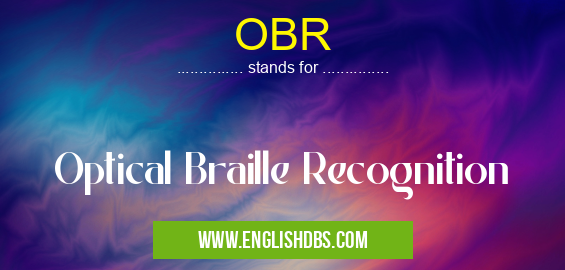What does OBR mean in UNCLASSIFIED
OBR stands for Optical Braille Recognition. It is an advanced technology that utilizes optical methods to automatically recognize and digitally represent Braille characters. Braille is a tactile writing system used by people with visual impairments, and OBR allows for efficient conversion of Braille documents into accessible digital formats.

OBR meaning in Unclassified in Miscellaneous
OBR mostly used in an acronym Unclassified in Category Miscellaneous that means Optical Braille Recognition
Shorthand: OBR,
Full Form: Optical Braille Recognition
For more information of "Optical Braille Recognition", see the section below.
OBR Technology
OBR systems employ sophisticated algorithms to process scanned images of Braille pages. These algorithms analyze the shape and position of Braille dots to identify individual characters and convert them into digital text. The resulting digital output can be stored, edited, and shared in various accessible formats, such as plain text, audio files, or electronic Braille displays.
Applications of OBR
OBR has revolutionized the way Braille materials are accessed and utilized by people with visual impairments:
- Document Accessibility: OBR enables the digitization of Braille books, magazines, and other documents, making them accessible to a broader audience.
- Education and Employment: OBR tools facilitate the creation of Braille教材s, improving educational opportunities for visually impaired students. Additionally, they support employment by allowing visually impaired individuals to read and respond to Braille correspondence.
- Communication: OBR enables the exchange of Braille messages between individuals, fostering communication and social interaction.
Benefits of OBR
- Increased Accessibility: OBR expands access to Braille materials, empowering people with visual impairments to engage with written content independently.
- Time Efficiency: OBR automates the process of Braille recognition, saving time and effort compared to manual transcription.
- Accuracy and Consistency: OBR systems provide accurate and consistent recognition of Braille characters, ensuring reliable digital representations.
- Portability and Convenience: OBR tools make Braille materials portable and easily accessible through digital devices.
Essential Questions and Answers on Optical Braille Recognition in "MISCELLANEOUS»UNFILED"
What is OBR (Optical Braille Recognition)?
OBR is a technology that uses optical techniques to recognize and interpret Braille characters printed on surfaces. It allows electronic devices like smartphones and computers to convert Braille text into digital format, making it accessible for individuals with visual impairments.
How does OBR work?
OBR utilizes image sensors to capture high-resolution images of Braille text. Advanced algorithms then analyze these images to identify the raised dots that represent Braille characters. The technology can recognize both single and multi-cell Braille characters, including contracted and uncontracted forms.
What are the benefits of OBR?
OBR offers several advantages:
- Accessibility: Enables individuals with visual impairments to access written materials and digital content independently.
- Convenience: Provides a portable and efficient way to convert Braille text into digital format.
- Accuracy: Advanced algorithms ensure high accuracy in character recognition, reducing the need for manual transcription.
- Support for multiple languages: Can recognize Braille characters in various languages, including English, Spanish, French, and others.
What types of devices support OBR?
OBR technology can be integrated into various electronic devices, including:
- Smartphones
- Tablets
- Computers
- Specialized portable OBR devices
What are the limitations of OBR?
Like any technology, OBR has some limitations:
- Lighting conditions: Requires adequate lighting to capture clear images of Braille text.
- Paper quality: Can be affected by the thickness and surface texture of the paper used for Braille printing.
- Curved surfaces: May not recognize Braille characters printed on curved or uneven surfaces.
How is OBR used in real-world applications?
OBR finds applications in various scenarios:
- Education: Helps students with visual impairments access educational materials and participate fully in classrooms.
- Workplaces: Enables employees with visual impairments to read documents, emails, and presentations.
- Public spaces: Provides access to information in museums, libraries, and other public places.
- Healthcare: Assists individuals with visual impairments in managing their medical records and health information.
Final Words: OBR technology has transformed the accessibility of written content for people with visual impairments. By providing efficient and accurate Braille recognition, OBR empowers individuals to access information, communicate, and participate fully in society. Its ongoing development and applications continue to enhance the lives of visually impaired individuals, fostering inclusion and empowerment.
OBR also stands for: |
|
| All stands for OBR |
